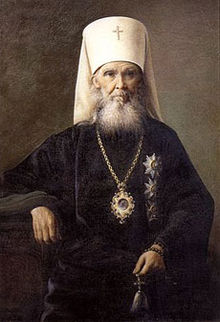Metropolitan bishop

In Christian churches with episcopal polity, the rank of metropolitan bishop, or simply metropolitan, pertains to the diocesan bishop or archbishop (then more precisely called metropolitan archbishop) of a metropolis; that is, the chief city of a historical Roman province, ecclesiastical province, or regional capital.
Before the establishment of patriarchs (beginning in AD 325), metropolitan was the highest episcopal rank in the Eastern rites of the Church. They presided over synods of bishops, and were granted special privileges by canon law and sacred tradition.
The Early Church structure generally followed the Roman imperial practice, with one bishop ruling each city and its territory.[1] The bishop of the provincial capital, the metropolitan, enjoyed certain rights over other bishops in the province, later called suffragans.[1]
Contents |
Orthodox

In the Eastern Orthodox Churches, the title is used variously. In the Greek Churches metropolitans are ranked below archbishops in precedence, and primates of local churches below patriarchal rank are generally designated as archbishops. The reverse is true for the Slavic Churches (Russian Orthodox, Bulgarian Orthodox, Serbian Orthodox, etc.) and for the Romanian Orthodox Church, where metropolitans rank above archbishops and the title can be used for primatial sees as well as important cities.
In neither case do metropolitans have any special authority over other ruling bishops within their provinces. However, metropolitans (archbishops in the Greek Orthodox Church) are the chairmen of their respective synods of bishops, and have special privileges.
Roman Catholic
- See also: Catholic Church hierarchy and Diocesan bishop

In the Roman Catholic Church, ecclesiastical provinces, composed of several neighbouring dioceses,[2] are each headed by a metropolitan, the archbishop of the diocese designated by the Pope.[3] The other bishops are known as suffragan bishops.
The metropolitan's powers over dioceses other than his own are normally limited to
- supervising observance of faith and ecclesiastical discipline and notifying the Supreme Pontiff of any abuses;
- carrying out, for reasons approved beforehand by the Holy See, a canonical inspection that the suffragan bishop has neglected to perform;
- appointing a diocesan administrator if the college of consultors fails to elect an at least 35-year-old priest within eight days after the vacancy of the see becomes known;[4] and
- serving as the default ecclesiastical court for appeals from decisions of the tribunals of the suffragan bishops.[5]
The metropolitan also has the liturgical privilege of celebrating sacred functions throughout the province, as if he were a bishop in his own diocese, provided only that, if he celebrates in a cathedral church, the diocesan bishop has been informed beforehand.[6]
The metropolitan is obliged to request the pallium, a symbol of the power that, in communion with the Church of Rome, he possesses over his ecclesiastical province.[7] This holds even if he had the pallium in another metropolitan see.
It is the responsibility of the metropolitan, with the consent of the majority of the suffragan bishops to call a provincial council, decide where to convene it, and determine the agenda. It is his prerogative to preside over the provincial council.[8] No provincial council can be called if the metropolitan see is vacant.[9]
All Latin Rite metropolitans are archbishops; however, some archbishops are not metropolitans, as there are a few instances where an archdiocese has no suffragans or is itself suffragan to another archdiocese. Titular archbishops (i.e. ordained bishops who are given an honorary title to a now-defunct archdiocese; e.g. many Vatican officials and papal nuncios and apostolic delegates are titular archbishops) are never metropolitans.
As of April 2006, 508 archdioceses were headed by metropolitan archbishops, 27 archbishops were not metropolitans, and there were 89 titular archbishops. See also Catholic Church hierarchy for the distinctions.
In the Eastern Catholic Churches, the metropolitan is the head of those autonomous particular Churches that, though they consist of several eparchies, are not large enough to be placed under the authority of a patriarch or a major archbishop. They are therefore somewhat more subject than patriarchal or major archiepiscopal Churches to oversight by the pope and the Congregation for the Oriental Churches.
Anglican
In the Anglican Communion, a metropolitan is generally the head of an ecclesiastical province (or cluster of dioceses) and ranks immediately under the primate of the national church (who is often also a metropolitan). Most metropolitans, but not all, are styled archbishop.
See also
- Exarch
- Metropolitanate of Montenegro and the Littoral
- List of Metropolitans and Patriarchs of Moscow
References
- ↑ 1.0 1.1 "metropolitan." Cross, F. L., ed. The Oxford dictionary of the Christian church. New York: Oxford University Press. 2005
- ↑ Code of Canon Law, canon 431
- ↑ Code of Canon Law, canon 435
- ↑ Code of Canon Law, canon 436 §1-2
- ↑ Canon 1438 no. 1.
- ↑ Code of Canon Law, canon 436 §3
- ↑ Code of Canon Law, canon 437
- ↑ Code of Canon Law, canon 442
- ↑ Code of Canon Law, canon 440 §2
External links
- List of Catholic Metropolitan Archdioceses in the world by Giga-Catholic Information
 "Metropolitan". Catholic Encyclopedia. New York: Robert Appleton Company. 1913.
"Metropolitan". Catholic Encyclopedia. New York: Robert Appleton Company. 1913.